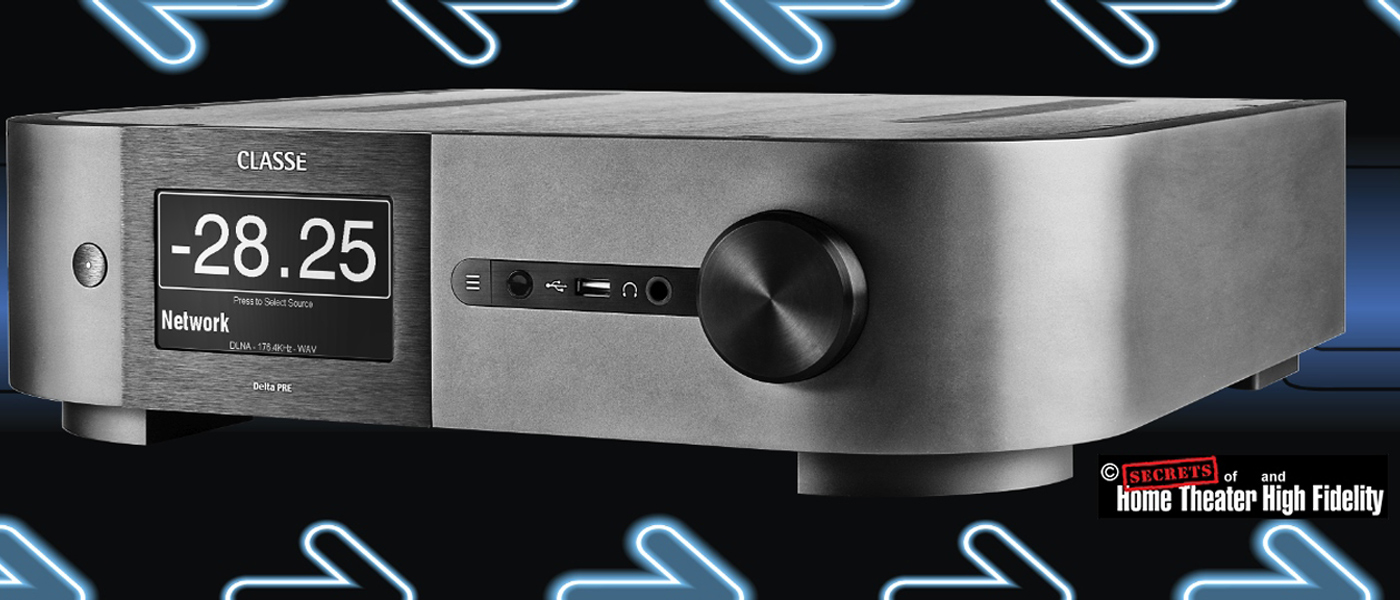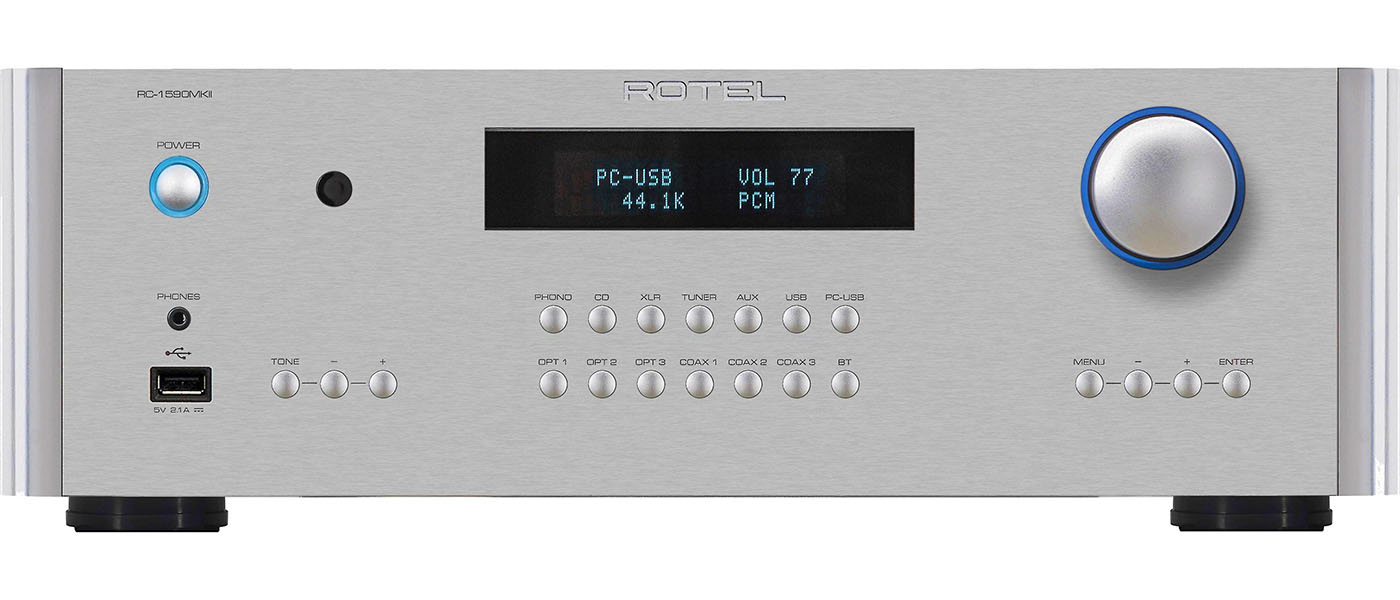
I’ll be reviewing the RC-1590 MkII Preamplifier alongside a previously reviewed RB-1590 stereo amplifier and reveal some insights from my extended listening of both.
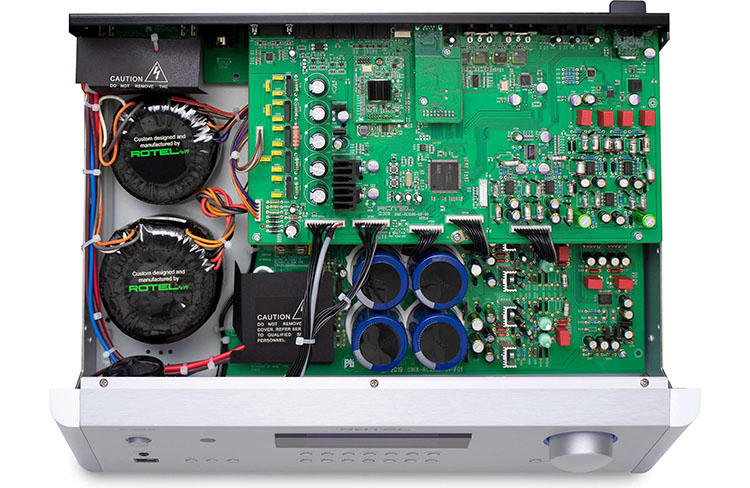
I first saw Rotel products back in my college days in the late 70s at a downtown high-end audio store. Back then, you could bring your favorite cassette tape or LP and demo the equipment firsthand. Rotel always had a distinctive design quality that set it apart from Sansui, Technics, Fisher, and other brands of the day. Rotel was known for its high-quality build and even higher-quality sound. It was the stuff you dreamed about but could not afford with a college salary. I’m pleased to finally have Rotel in my music room and the sound and build quality are still everything I could have hoped for. Yes. It was worth the wait!
Rotel RC-1590 MkII Stereo Preamplifier and RB 1590 Stereo Amplifier
- Capacitors directly coupled to the audio signal path for improved frequency response
- Moving-magnet phono stage
- Isolated independent DC power supplies for lower noise floor
- AptX and AAC Bluetooth with TI 32 bit/384 kHz DAC
- MQA/MQA Studio support and Roon tested
- Balanced XLR input and outputs
- Dual in-house manufactured toroidal transformers
- Computer USB-B and USB input for an iOS phone or tablet on the front
Rotel bills the RC-1590 MkII Preamplifier as an upgraded version of the original with technology and some parts from their top-of-the-line Michi products. Their beautiful yet sparse industrial design is still there. A display, volume knob, and few selector buttons are on the front panel. The logo is stamped deeply onto the faceplate as well. The operator’s manual is on a USB stick that also carries the software driver files for the PC-USB input. Even without the manual, I had the RC-1590 MkII plugged into the RB-1590 power amp in under 15 minutes.
The RC-1590 MkII Preamp has parts that are manufactured around the globe and chosen for their sound quality. Split-foil capacitors are more costly to incorporate, but the quality of sound is paramount in Rotel’s philosophy. On the back, we have four unbalanced stereo RCA inputs, three TOSLink and three coaxial digital inputs (24/192), a PC-USB input (32/384), a balanced XLR stereo input, two stereo RCA preamp outputs, two stereo XLR outputs, two RCA mono subwoofer outputs, an ethernet port which connects the preamp to your home network for software updates and integration with 3rd-party control systems. It is Crestron compatible and has 2 3.5mm 12-volt trigger outputs.
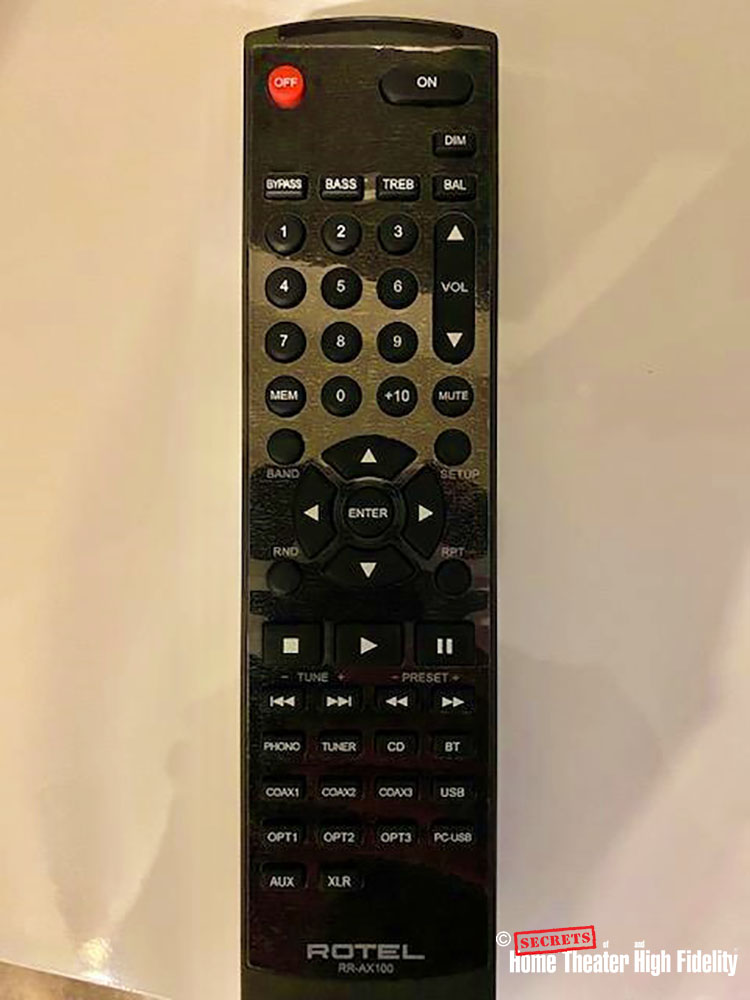
The remote is robust with easy-to-read graphics. It is all plastic and does not have back-lighting. It is much heavier than my Marantz home theater remote and feels good in the hand. The power cord is detachable should you wish to upgrade it in the future. The RC-1590 MkII comes with a 5-year warranty.
Secrets Sponsor
When powered on manually, the power button gives a nice solid click, and a blue ring appears around it. The display is dimmable and getting into the menu is intuitive, though a mis-selection can throw you all the way back to the beginning if you’re not careful. Luckily, you’ll likely just set things up once then leave them alone. I connected to Bluetooth quickly and the RC-1590 MkII appeared on my iPhone 11 as Rotel Bluetooth. The connection was solid and never gave me trouble during the review period.
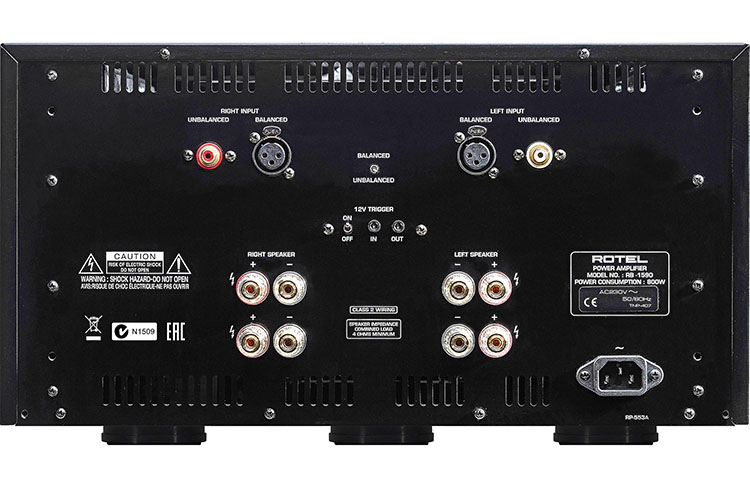
The RB-1590 amplifier has been previously reviewed here, so I will not go into too much detail about it. The RB-1590 is at the top of its class as a 2 x 350-watt stereo amplifier with dual toroidal transformers and special split foil capacitors. At $3499.99, it is priced competitively with other similar high-end products. It is the perfect match for the RC-1590 MkII and is one of the heaviest amplifiers I have auditioned, weighing in at 84 pounds. I almost expired when I had to carry it upstairs to my media room. In dimensions and weight, it dwarfs my Emotiva LPA-1 seven-channel amplifier. It is a beast, with balanced and unbalanced connections, a 12-volt trigger, and heavy-duty connectors. Again, if you manually turn the amp on, the power button has a blue light that has the same satisfying click to it. It, too, exudes quality and the sonics were superb.
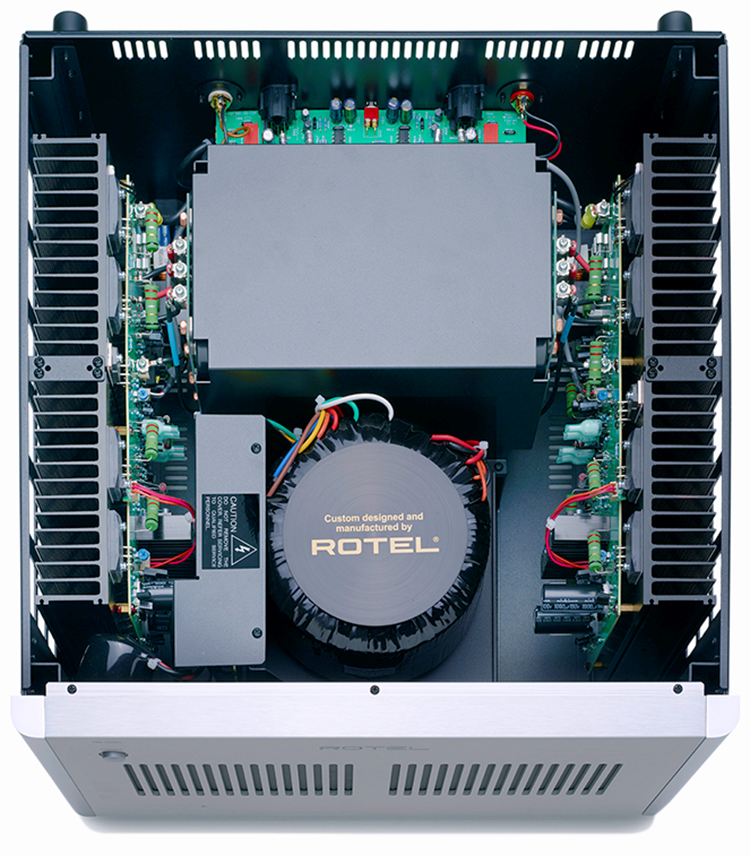
In particular, the bass extension really made my Sonus faber Sonetto Vs sing with plenty of power and gut-punching bass to make stereo listening a real pleasure. I normally do not listen to two products at once because it is hard to say which single item has the biggest impact on the sound. However, I can say that these two working in tandem are stunning with effortless sound and a wide, deep soundstage. If your current speakers have good imaging, this combo will bump your listening up a few notches!
Rotel RC-1590MKII Preamp
Total Harmonic Distortion (20 Hz – 20k Hz):
< 0.002%
Input Sensitivity / Impedance:
Phono Input (MM) 2.5 mV / 47k ohms
Line Level Inputs (RCA) 150 mV / 100k ohms
Line Level Inputs (XLR) 250 mV / 100k ohms
Frequency Response:
Phono Input: 20Hz – 20kHz, ±0.2dB
Line Level Inputs: 10Hz – 100kHz, ±0.1dB
Signal to Noise Ratio (A-weighting):
Phono Input: 80dB
Line Level Inputs: 112dB
Channel Separation:
Phono Input: > 75dB
Line Level Inputs: > 75dB
Digital Section:
Frequency Response 20Hz – 20kHz (±0.5dB, Max)
Digital Inputs:
SPDIF LPCM (up to 192kHz/24-bit)
PC-USB:
USB Audio Class 1.0 (up to 96kHz/24-bit)
USB:
Audio Class 2.0 (up to 384kHz/32-bit)
Power Consumption:
45 watts
Standby Power Consumption:
< 0.5 watts
Dimensions (W x H x D):
17″ x 5 11/16″ x 13 7/9″ inches
Net Weight:
22.27lbs
MSRP:
$2099.99
Rotel RB1590 Power Amp
Continuous Power Output:
350W/Ch x 2 (All channels driven, 8Ω)
Total Harmonic Distortion (THD):
(20Hz–20kHz) <0.03%
Frequency Response:
10Hz – 100kHz ±0.5dB
S/N Ratio (IHF “A” Weighted):
120dB
Gain:
RCA: 27.5dB
XLR: 23.5dB
Intermodulation Distortion (60Hz:7kHz, 4:1):
<0.03%
Damping Factor:
300
Speaker Impedance:
4Ω minimum
Input Sensitivity:
Line Level Inputs (RCA): 2.2V
(XLR): 3.5V
Input Impedance:
Line Level Inputs (RCA): 12kΩ
(XLR): 100kΩ
Channel Separation:
>50dB
Dimensions (W × H × D):
17″ × 9.75″ × 17.9″
Net Weight:
38.1kg (84lbs.)
MSRP:
$3499.99
Website:
Company:
SECRETS Tags:
rotel, ampliphier, amphlifier review, review 2021, rotel review 2021
I placed the RC-1590 MkII on top of the RB-1590 mainly for aesthetics and after playing music for a few hours, I realized it generated very little heat. I used balanced connections and played most selections from Qobuz through my phone or my Oppo UDP-203. I connected to my NAS via the Oppo as well with its large library of high-resolution music files. My speaker wire is a 12 gauge from Blue Jeans cable company with banana terminations.
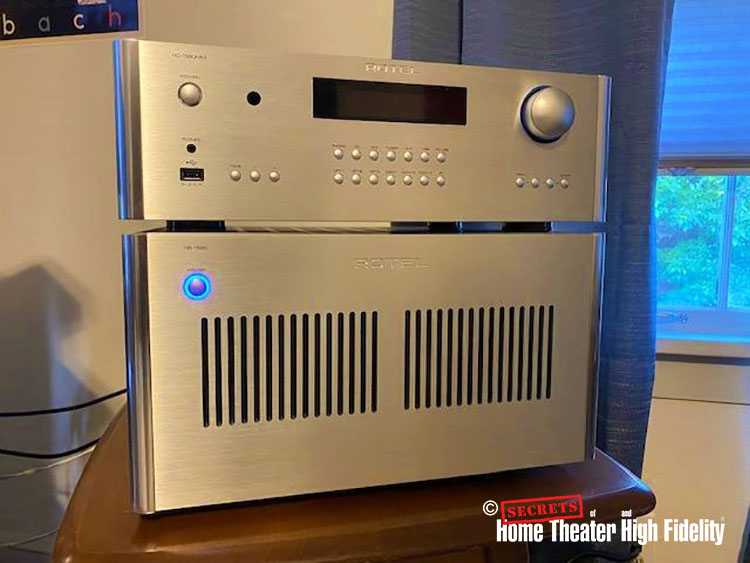
I placed both of the Rotels on a sturdy lamp table in my media room because I did not want to bend over once I had it unpacked. The preamp is about 30 pounds, but that amp outweighs my age! Both products are “buy it once, buy it for life” type products.
When powered on, the RC-1590 MkII is defaulted to tone control bypass. You can do bass and treble adjustment on the front of the unit or through the remote. Next, it will let you select the balance, then the display dimmer which has seven choices from full on to completely off. You can set the max volume to a setting of your choice so when you return to music listening, it remembers the last setting and returns to it. A timer for auto shut off can be set as well from 1, 2, 5, or 12 hours, or disabled altogether. All inputs can be fixed or variable volume levels, which is nice. Class 1 or 2 can be selected for the PC USB input. MQA defaults to 24 bits, but 32 bits can also be selected for high-resolution PC audio. If you hook the RC-1590 MkII up with an ethernet cable, software updates can be pushed automatically. This feature is starting to become more common these days.
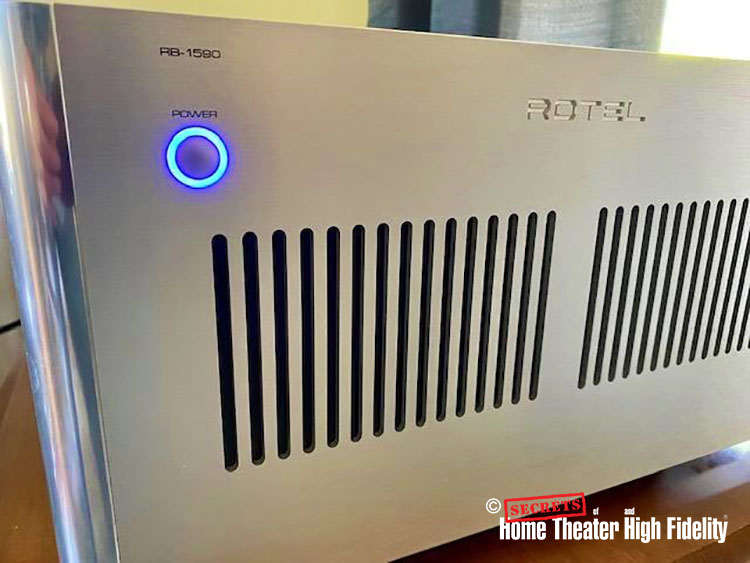
Be aware that this combo is designed for musical purity, so there is no room correction software. If you add a subwoofer, several now can be purchased that have an app for setting up a single or dual subwoofer (SVS comes immediately to mind). I did not use any of my subs as the Sonus fabers can go low enough for almost all my music tastes.

Britten “Young Person’s Guide to the Orchestra”
Orchestral music can provide a wide range of dynamics, soundstage, timbre, and the distinctive sonic signatures of strings, woodwind, brass, and percussion. Britten’s Young Person’s Guide to the Orchestra literally hits every instrument with a solo section highlighting it. Everything from the triangle to the timpani is beautifully recorded here by Prof. Keith Johnson and the sound was thrilling and startlingly real. The Rotel combo was everything I expected and was impressed (for the hundredth time) by the naturalness and dynamics of this recording. Strings shimmered, the brass had that distinctive “blat” ringing and the double basses growled.
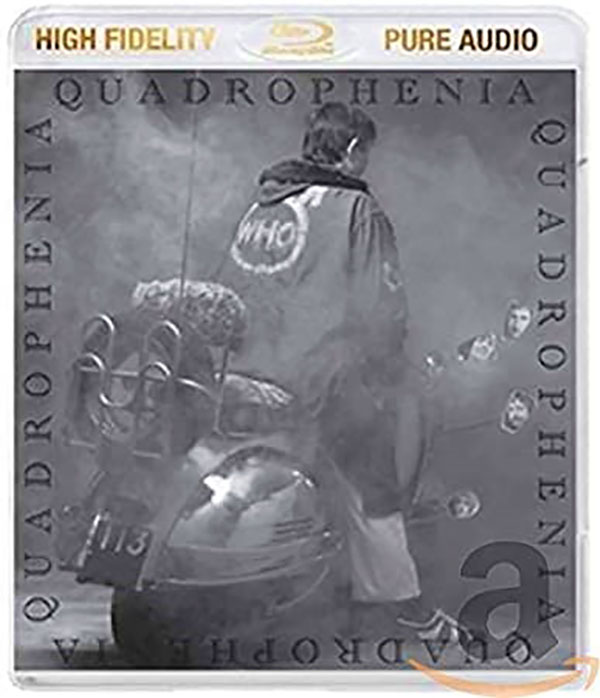
The Who “Quadrophenia”
The hi-res (24-bit/96kHz) stereo version of Quadrophenia, by The Who, sounded impressive on the Rotel combo. The vocals are more forward in this mix and Moon’s frenetic drumming was spread out across the front of the room. The soundstage was wide and deep enough to trick me into thinking I had the 5.1 mix engaged. The solidity of the bass made the experience more realistic and natural.

Diana Krall “The Girl in the Other Room”
For true intimacy, I always return to Diana Krall’s The Girl in the Other Room. Here, her smokey voice sounded up close and personal. Occasionally, you can hear an intake of breath or a finger sliding on the string of the double bass. All the details that make music listening so enjoyable were captured remarkably by the Rotel duo.
Bench tests and analysis by John E. Johnson Jr.
Secrets Sponsor
I used the XLR balanced inputs for the main preamplifier tests, the RCA coax input for the DAC tests and the RCA inputs for the phono preamplifier tests. The XLR balanced outputs were used. Bandwidth was 80 kHz unless otherwise noted.
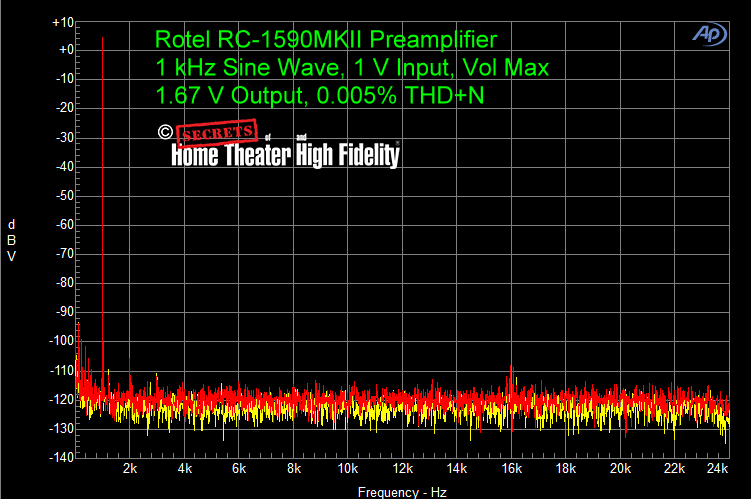
First, the main preamplifier tests. With a 1 Volt 1 kHz sine wave input, the volume control set to “Max”, output was 1.67 Volts, which means the preamplifier gain is unity plus 67% with one frequency (this number goes down with the increasing number of frequencies in the test signal). Distortion was a very low 0.005%. Noise was at -120 dBV except for some spurs below 1 kHz and some at 16 kHz.
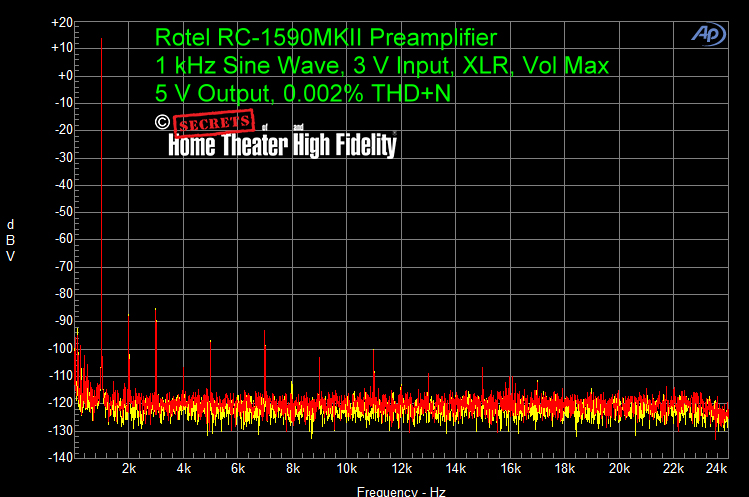
Raising the input voltage to 3 Volts produced 5 Volts output and 0.002% THD+N. Although there are more distortion peaks, the distortion value is lower because the noise floor remained the same, so the percentage of THD+N related to the output voltage is lower. Regardless, the result is very good.

Using 19 kHz and 20 kHz sine wave test signals with 1 Volt input and 1.18 Volts output, the spectrum is superb. This is a typical listening level input to a power amplifier.
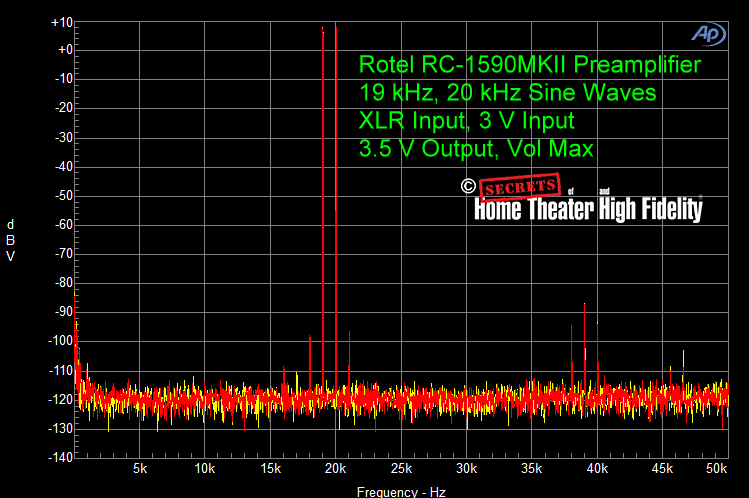
At a higher input and output voltage, some IM spurs can be seen, but there are not very many of them. Again, an excellent test result.
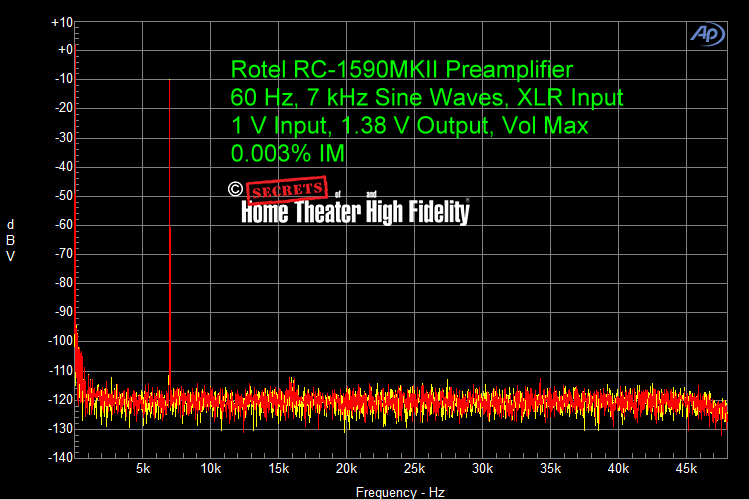
The standard IM test is shown below, using a 60 Hz and 7 kHz sine wave. With a 1 Volt input and 1.38 Volt output, there was only 0.003% IM distortion.
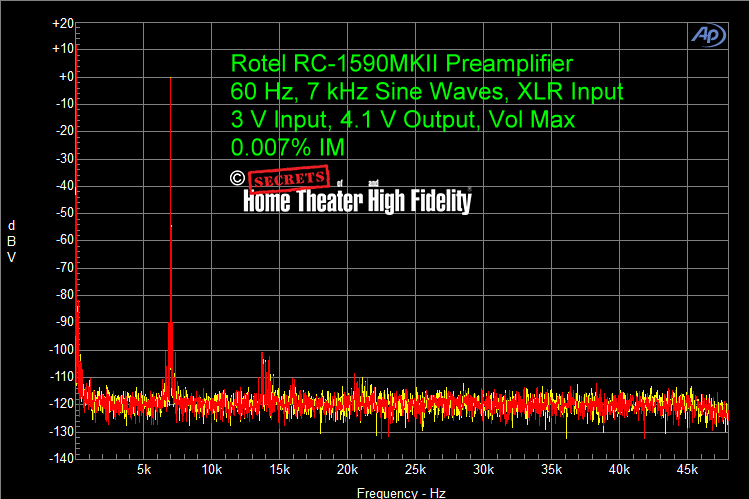
At 4 Volts output, several IM peaks can be seen, but the total is low. 0.007% IM with a 4 Volts output is excellent.
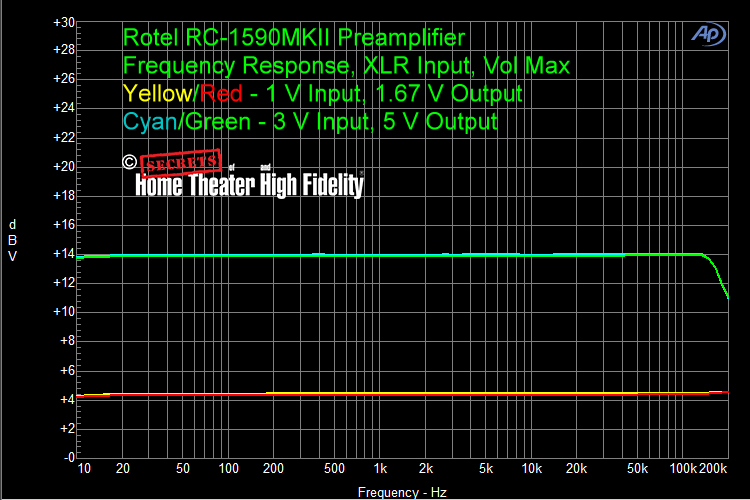
The Frequency Response (FR) for the main preamplifier is shown above at two voltage outputs. It is reasonably flat out to 200 kHz at 1.67 Volts output and attenuates sharply at 150 kHz, 5 Volts output.

Let’s take a look at the FR, 1 Volt input, 1.67 Volts output using an expanded Y-axis. It is very flat (within 0.01 dB) from 20 Hz to 20 kHz, and within 0.13 dB from 10 Hz to 50 kHz. This is really quite good. The two channels are within 0.08 dB of each other in terms of their output level.

Here is the THD+N vs. Frequency with 1 Volt input and 1.66 Volts output. It shows 0.005%, or less, THD+N from 10 Hz to 50 kHz. This is with a 500 kHz bandwidth. Superb results.
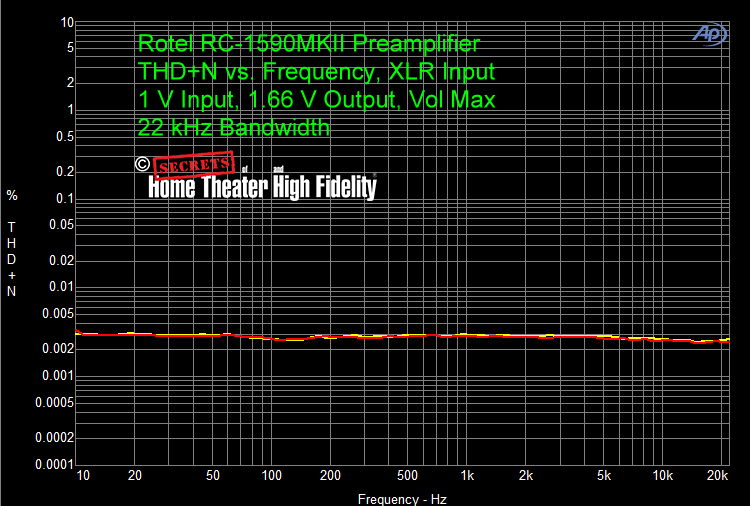
With a 22 kHz bandwidth, it is 0.003%, or less, THD+N.
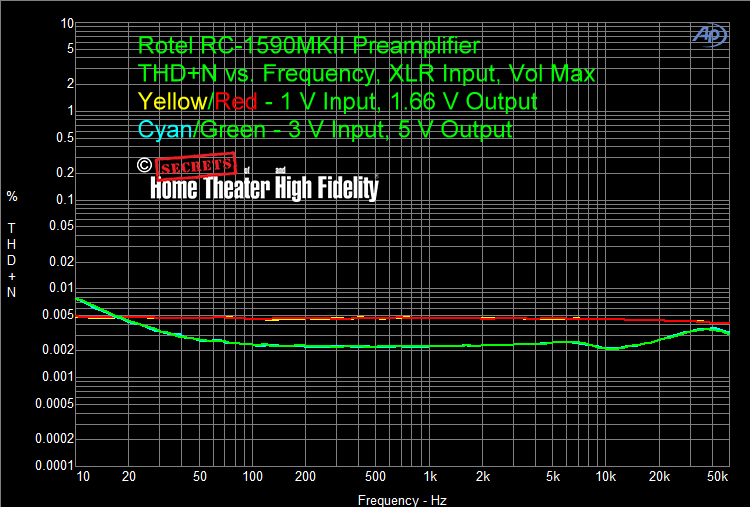
With a higher output voltage and the 80 kHz bandwidth, THD+N stays below 0.003% for most of the audible spectrum. It is higher between 10 Hz and 100 Hz, and between 27 kHz and 50 kHz, but this is expected. However, it does not go above 0.003%. A 5 Volts output is enough to drive a 2,000-watt power amplifier!
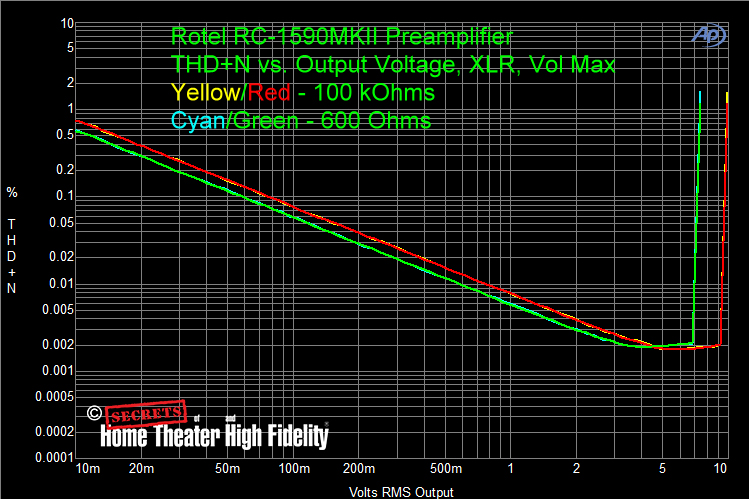
THD+N vs. Output Voltage at 1 kHz into 100 kOhms and 600 Ohms is shown above. Even with a 600 Ohms load (a stress test, not an input impedance that would actually be on any power amplifier), the result is astonishing, i.e., 7 Volts output at 0.002% THD+N. I don’t know how Rotel did this for $2,099.99 MSRP. It means the RC-1590MKII stereo preamplifier will fully drive any known power amplifier and have low distortion.

The Hum Spectrum, shown below, has even-ordered harmonics of the 60 Hz AC signal, with the 2nd harmonic, 120 Hz, at – 94 dBV which is 20 µV RMS. This was with a 1 kHz sine wave test signal on. I also measured a hum spectrum with the test signal off, and it was the same result as with the test signal on.
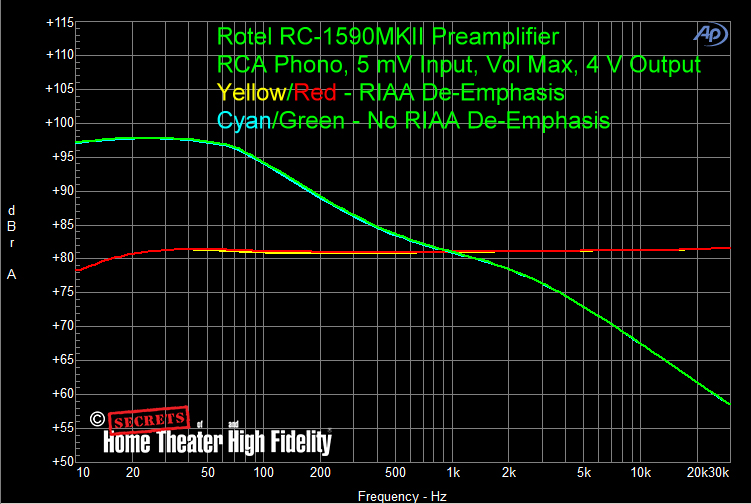
The Rotel RC-1590MKII has a built-in MM (Moving Magnet) phono preamplifier. The RIAA accuracy curve is shown below. This is done by sending an appropriate level signal (5 mV) to the preamplifier which has an RIAA Pre-emphasis curve applied. This is similar to what would be sent to the preamplifier from an MM phono cartridge playing an LP on a turntable. The phono preamplifier applies an RIAA De-emphasis curve.
The spectrum shows the frequency response (FR) of the phono preamplifier with the De-emphasis curve applied (Yellow/Red), and also the frequency response without any RIAA Pre-emphasis curve applied (Cyan/Green). You can see that the De-emphasis is + 20 dBr at 20 Hz and – 20 dBr at 20 kHz. It is approximate due to the phono preamplifier’s own frequency response.

Here is the FR with the De-emphasis curve applied, and with an expanded Y-axis. The FR is within 0.6 dBr 20 Hz to 20 kHz. The response has a low-frequency bump and a rise above 1 kHz to 20 kHz. Every phono preamplifier has its own “personality” because of the very low voltage it is dealing with and because its RIAA De-emphasis curve is applied using a set of resistors and capacitors. That set (network) of resistors and capacitors is not necessarily the same for all phono preamplifier designs, and the network is usually placed in the path of the feedback network which is also specific to the particular preamp design.

THD+N vs. Frequency with a 5 mV input shows rising distortion with rising frequency, which is expected. At 20 kHz, distortion approaches 1%.
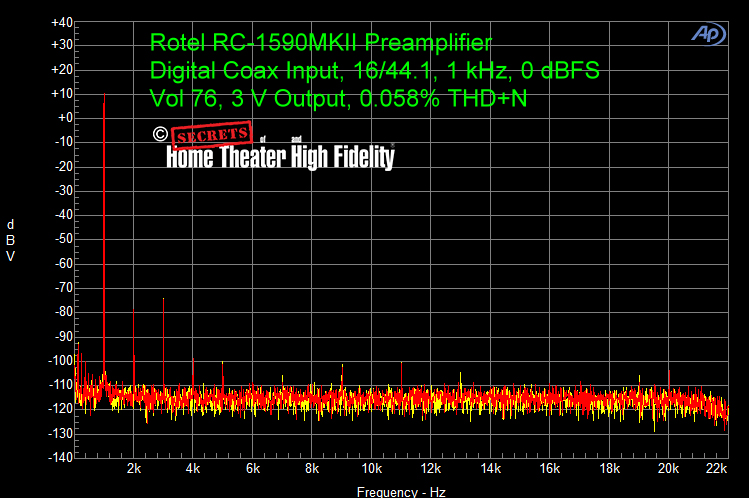
The RC-1590MKII also has a DAC. Let’s take a look at its performance. First, a 1 kHz sine wave using 16/44.1 sampling, 0 dBFS (maximum input), which gave a 3 Volt output. THD+N was 0.058%.
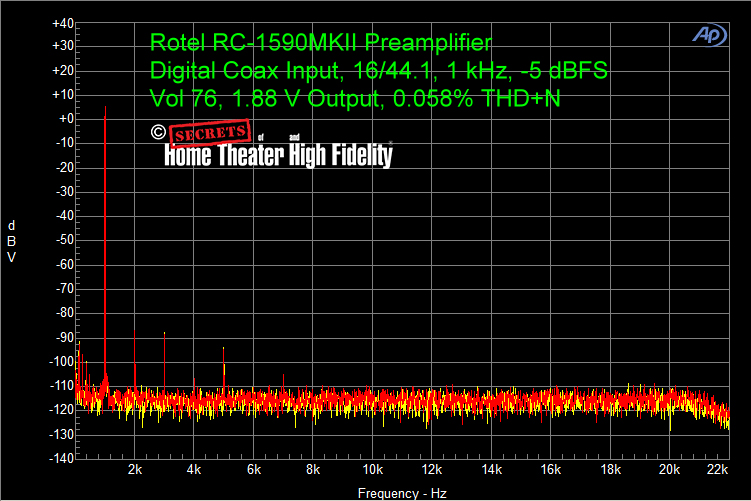
Now, lowering the input level to – 5 dBFS, which produced a 1.88 Volt output, distortion was the same (0.058%), but the number of distortion peaks is lower. The distortion level is the same because the output level is lower.
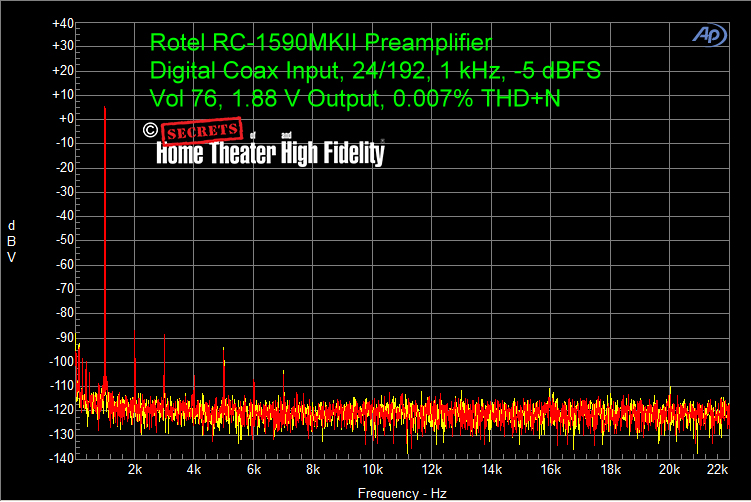
With 24/192 sampling, 1 kHz, – 5 dBFS, 1.88 Volt output, distortion was 0.007% even though the number of peaks is a bit more than with 16/44.1 sampling. This is because the noise floor is lower at 24/192 sampling.
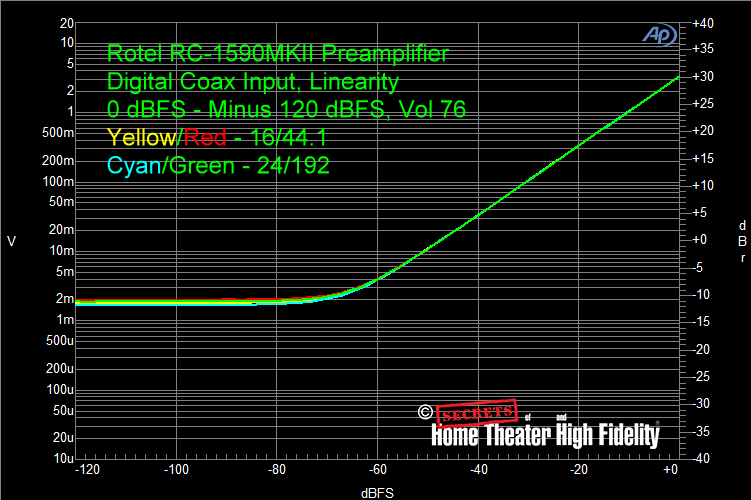
The linearity of the DAC is shown above. For both 16/44.1 and 24/192, it is linear down to – 68 dBFS.
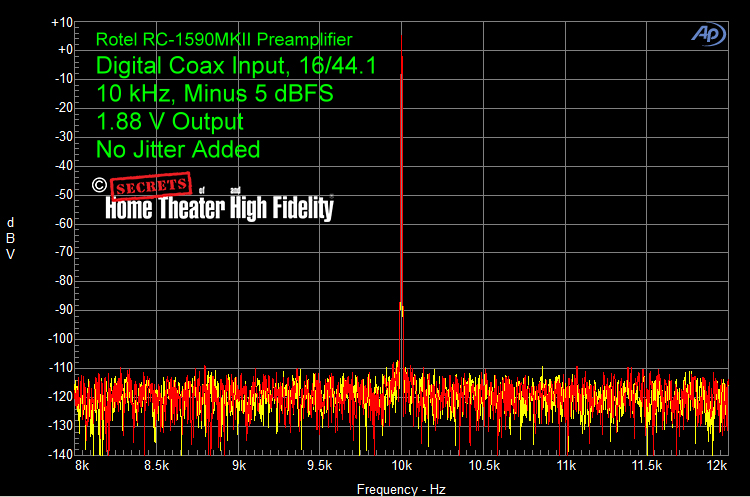
Here are the jitter tests. First, the 10 kHz sine wave with no jitter added. This is with 16/44.1 sampling.
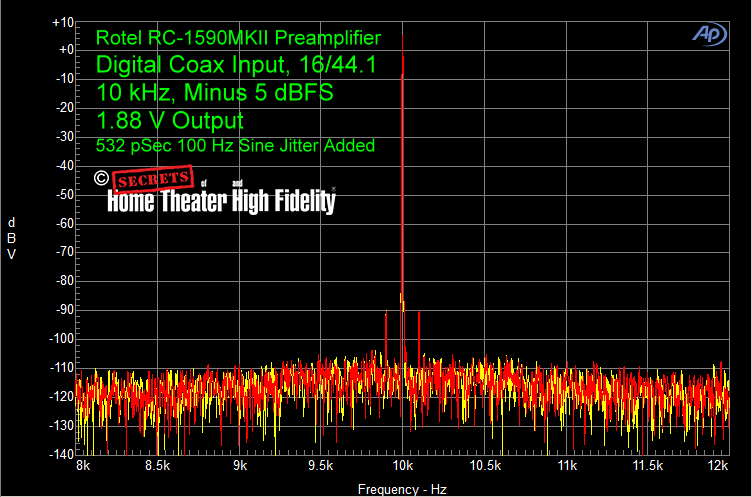
Now, with 532 pSec of 100 Hz jitter added. You can see the 100 Hz peaks on either side of the 10 kHz sine wave.

With 177 pSec of jitter added. The 100 Hz peaks are about 5 dBV above the noise floor.
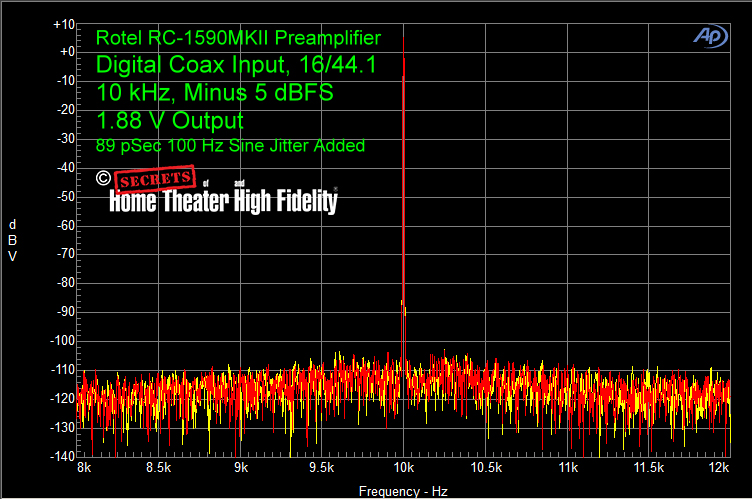
And, now, with just 89 pSec of jitter added. No 100 Hz peaks are visible.
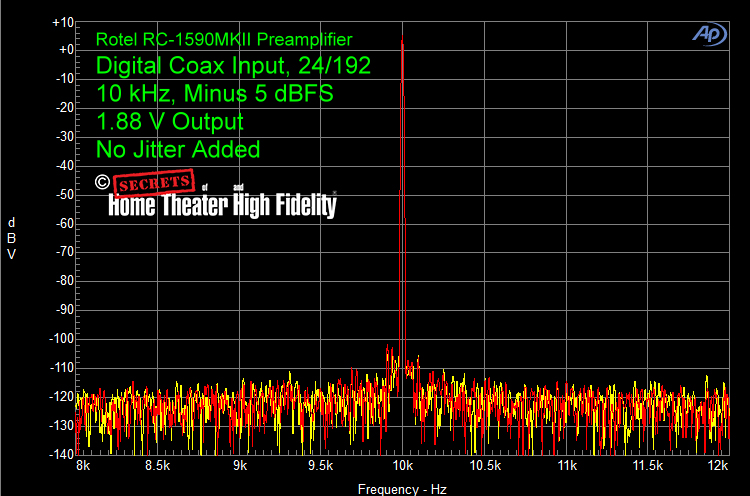
Here is the test signal at 24/192 sampling, with no jitter added. The noise floor is lower than at 16/44.1 sampling, and there are some peaks next to the test signal, but they are not symmetrical, so they do not represent jitter.
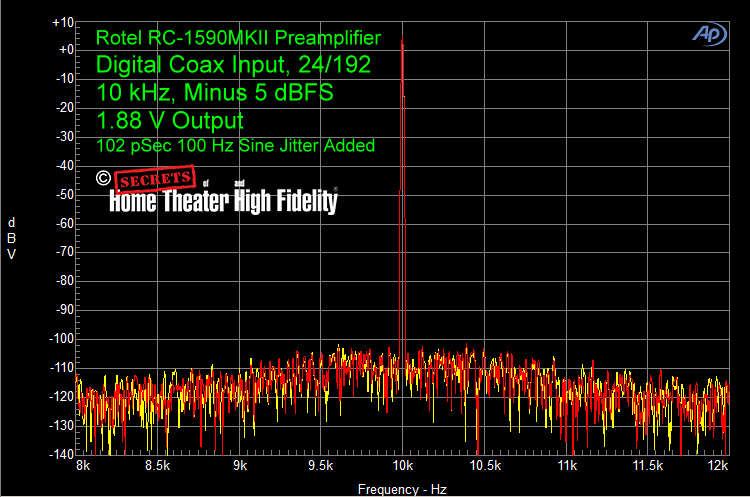
At 24/192 sampling with 102 pSec of 100 Hz jitter added. No 100 Hz peaks are visible. So, jitter performance is about average for a modern DAC.

The DAC FR is shown above. It is standard for 16/44.1, 24/96, and 24/192 sampling in terms of the roll-off above the Nyquist frequencies for each sampling type. The output stage does roll-off 0.4 dB from 100 Hz to 20 Hz, and 0.9 dB from 10 kHz to 96 kHz (down 0.02 dB at 20 kHz). So, you might have to crank your subwoofer a bit.

THE ROTEL RC-1590 MKII is one of the finest sounding preamps I’ve heard. It delivers high-end sound and build quality at a reasonable price.
- Lifetime build quality
- Top-notch musicality, with finesse and power
- Distinctively elegant and minimalistic Rotel styling
- Ample power
- No flaws of consequence
My wait for finally getting some Rotel products into my media room is finally over and I was not disappointed with my time with the RC-1590 MkII Preamplifier and RB-1590 Power Amplifier. The amp is a beast while the preamp delivered some of the sweetest stereo listening I’ve heard in some time. I never heard the original RC-1590 preamp, but the MkII is well designed and sounds fantastic. I am a big proponent of surround music, but the Rotel RC-1590 MkII and RB-1590 combo could easily seduce me back to the world of two-channel music again.


